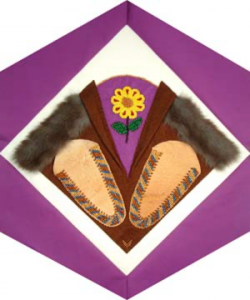Carrier

The Block
Hilda George, from Takla Landing, learned how to sew and bead as a child. She often makes moccasins, vests, and jackets from moose hide that she has tanned and smoked, using the traditional methods of her people. An example of her work, taken from a pair of moose-hide moccasins, is featured on the Carrier block. The beading is done in a pattern made more beautiful because of its simplicity. An heirloom Carrier bag provided the floral motif, which was reproduced at the top of the V-shaped formation. A single flower boldly peeks out from behind folds of felt that are framed with fur.
Cultural Profile
The Carrier speak the Dakelh language (of the Athapaskan language family) and call themselves Dakelh-ne, meaning “people who go upon the water,” since canoes were their main mode of transportation. They earned the name “carrier” from English traders (and porteurs from the French) because of a specific custom among the easternmost bands. Upon the death and cremation of her husband, a Carrier woman would, as a sign of respect, carry his ashes and bones for a period of mourning. Under pressure from the white man, Cremation was abandoned in favour of burial in the 1830s.
The traditional territory of the Carrier Nation is located in the mountainous interior of northern British Columbia, between the Rocky Mountains and Coastal Range, around the Upper Fraser and Skeena Rivers and their many tributaries. Their neighbours are the Gitxsan, Chilcotin and Sekani, with whom they developed a thriving trade network, before contact with white people. Today, there are 18 Carrier bands living in this area.
The Carrier depended, in large part, on the annual salmon runs. When abundant, the salmon harvest would provide enough to be dried and stored in preparation for the long winters. The Carrier had many methods of fishing that included weirs, large scaffolds erected over rough waters, conical traps, large rakes, three-pronged spears, and lures and hooks. When the fish supply was inadequate, the Carrier relied on small game hunting and some large game animals, such as moose and caribou. Their diet was often supplemented with local vegetation, such as berries, bulbs, and wild turnips.
Social mores and religious instruction were taught to the younger generations through the art of storytelling, or Gidete. The collective knowledge of the people includes traditional ways, social organization and land divisions (keyoh), and is passed down through the elders and hereditary chiefs. The Carrier people have always valued their land, and keyoh holders were responsible for taking care of their section. Keyoh holders were chosen as children by the leaders of the community. They were trained in their responsibilities to maintain the land and its resources, thereby ensuring the well-being of their clan. The Carrier Sekani Tribal Council believes this is a viable system that is still workable within the context of our times.
Sponsor: Kinette Club of Cornwall
